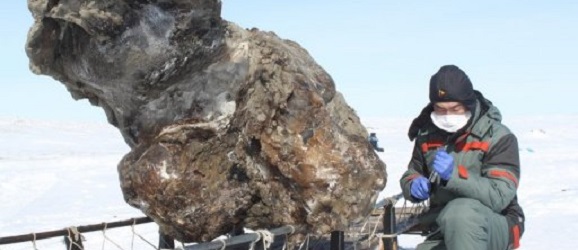Russian Scientists Discover The Most Well-Preserved Mammoth Carcass Ever
This article is more than 2 years old
 When we talk about ways that humans are destroying the world, our involvement in global warming often comes up. We’ve got to curb our vehicular exhaust. We have to stop the cows from burping so much. We have to stop relying on fossil fuels. Let’s for a second think not about how to prevent global warming, but how to end the oncoming apocalypse once it gets here, before one of those statements becomes, “We’ve got to stop cloning all these mammoths.”
When we talk about ways that humans are destroying the world, our involvement in global warming often comes up. We’ve got to curb our vehicular exhaust. We have to stop the cows from burping so much. We have to stop relying on fossil fuels. Let’s for a second think not about how to prevent global warming, but how to end the oncoming apocalypse once it gets here, before one of those statements becomes, “We’ve got to stop cloning all these mammoths.”
A team of Russian scientists led an expedition through recently thawed grounds in remote areas of northern Russia and found the most well-preserved mammoth carcass ever discovered. (It had blood in it!) Half-buried in ice for 10,000 to 15,000 years, the carcass is believed to have been around 60 years of age when it died, and it’s the first time an old female mammoth has been found. Lots of guys around and no women? Sounds like as good a cause for extinction as any, as well as sounding like a boring prehistoric weekend. (Yes, I know that’s not why they went extinct.)
The mammoth’s lower region ended up in a pool of water and eventually froze, preserving that portion of the body quite well. The upper body, including the head and the back, were sticking up out of the ice and were assumed to have been munched on by predators.
“When we broke the ice beneath her stomach, the blood flowed out from there, it was very dark,” said Semyon Grigoryev, head of the expedition and scientist at the Yakutsk-based Northeastern Federal University. “This is the most astonishing case in my entire life. How was it possible for it to remain in liquid form? And the muscle tissue is also red, the color of fresh meat.” What a coincidence, I happen to have just made a mammoth steak sauce from things found on my refrigerator door. (Mind the magnets.)
Northeastern Federal has a deal with pioneer dog-cloner Hwang Woo-Suk from the Sooam Biotech Research Foundation in South Korea, and the eventual goal is to get this mammoth DNA studied for live cells, so that cloning the animal is at least possible. Scary? Sure. Interesting? Hell yes.
Don’t go looking for it yourself though. To avoid carcass looting, the scientists are keeping the remains in an undisclosed location. I’ve got insider information though. Just follow the yellow brick road until you pass Atlantis and then hang a left. If you pass Jimmy Hoffa’s body, you know you’ve gone too far.












